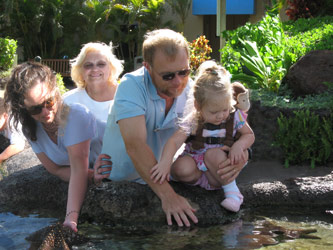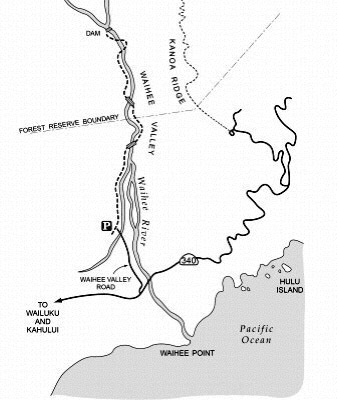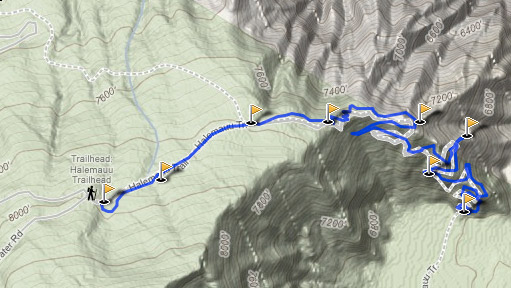
Jerry and Heather's
| • Albums | • Movies | • Calendar | • Links | • Contact us |
| Restaurants |
| Places to stay |
| Maps |
| Shows |
| Markets |
| Beaches |
| Hula Shows |
| Gardens and Galleries |

DRIVES AND HIKES |
Waihee Valley Trail - This is a relatively easy two mile hike north of Kahului that requires hikers to have a permit from the Wailuku Agribusiness. The trail starts as a simple dirt road, gradually opening up into a forest cut by streams (and rope bridges!) before bringing its traveler's face to face with the 2000 foot Mana-nole Falls. Waihee Ridge Trail - This is a scenic hike that is a lot more strenuous than the valley trail with steeper and more demanding climbs. Passing through guava and kukui filled forests, cloud covered gulches and the beautiful Makamakaole Falls this is the gem of hikes. You'll soon come to a Y intersection with Highway 340 where you will want to bear left through Waihe'e Town. Look for the school on your left and then keep your eye out for Waihe'e Valley Road. Turn left and continue on until you see mile marker 5. You'll see a grass turnout where you can park just past the taro patch on your right. Of course, if you travel with Maui Eco-Adventures, you won't have to worry about any of these directions! All you will need to do is enjoy the ride and look at the beautiful scenery. From the Ka'anapali Resort area the trip will take about an hour. From the Kihei and Wailea area, the trip will be somewhat shorter. Walk up the road and you will see a small enclosed stand on you left with a portable toilet nearby. The stand sells fresh and roasted macadamia nuts grown on the property, as well as snacks and sodas. Access to the rainforest hike in the Waihe'e Valley requires advance preparation for hikers who attempt to go on their own. The hike crosses land that is privately owned by the farmer who has set up the small stand. He charges a nominal fee of $5 for tourists and $2 for residents to cross his property and also make use of the toilet. The majority of the hike takes place on land owned by Wailuku Agribusiness and those not going on a tour with Maui Eco-Adventures first need to secure a permit from them at their headquarters in Wailuku. When hiking in a rainforest, where conditions can change rapidly, it is best to go with an experienced guide. Therefore, we recommend that you go with Maui Eco-Adventures who will take care of all of the fees and permits required.
HALEAKALA NATIONAL PARK Haleakala crater, the top of the volcano, is easily reached by car. Lots of people like to go up for the sunrise on the first day here because they go to bed early and wake up at 3am due to the time change. Kula lodge (you'll pass it at about 4000 feet on the way down) has bananas foster pancakes. Haleakala (The House Of The Sun) is the 3rd largest dormant volcano in the Hawaiian chain that reaches an elevation of 10,023 feet. There are over 28 miles of hiking trails through out the park. The National Park Service offers free guided hikes, star gazing programs and natural history exhibits. $10.00 per car admission fee to the park, free with a senior national parks gold pass.
ROUTE: The Halemauu Trail begins on the west side of the crater. The first mile is fairly level traversing a high elevation native shrub type to the crater rim in 0.7 miles providing excellent views of the crater and Koolau Gap. A series of switchbacks descend to the crater floor and into the east end of Haleakala Crater. The switchbacks negotiate the steep 1,500 foot cliff. At the crater floor the trail follows the west rim for one mile to the Holua cabin for a total of 4 miles. The vegetation in Koolau Gap and in the vicinity of Holua cabin is very sparse as it grows on rough lava. The cabin is located at an elevation of 7,000 feet. The trail continues another six miles across the crater floor to Paliku cabin.
IAO VALLEY This is one of the prettiest and easiest hikes on the island. The paved walkway takes you to the incredible Iao Needle. For the more adventure some you can continue up the stream to some nice pools for a quick dip. If you enter Wailuku from the west on Highway 30 (High St in Wailuku) Turn Left at Main St. and continue to the signed turn off right toward Iao Valley and take it to the end. Within the valley and sitting side by side, are the Kepaniwai Heritage gardens and the Hawaiian Nature Center, both containing examples the lives and times of the Islands diverse cultures and the land they inhabit. At the end of the road is the "Iao Valley State Park", a remarkable area and a must see. What water sports do you enjoy. Jer Go Dive Maui. |
